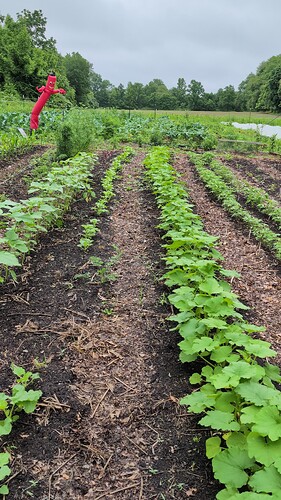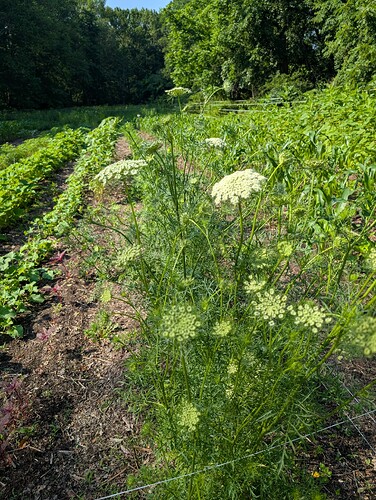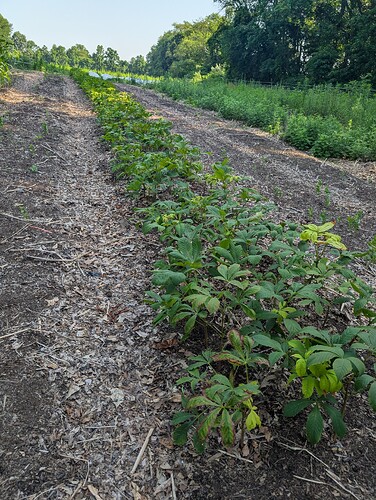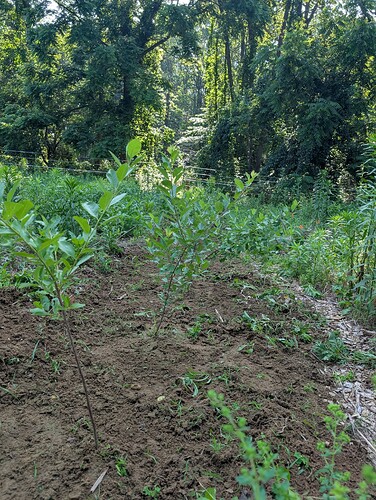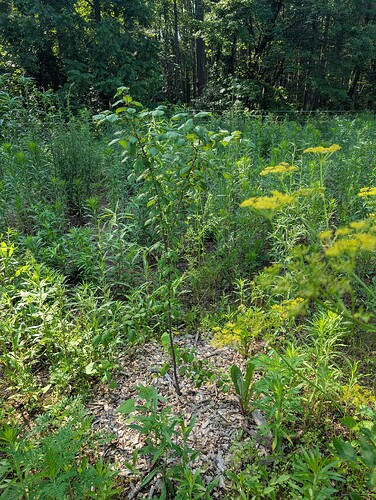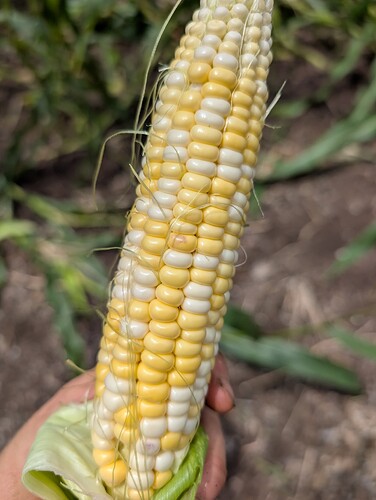Here’s the map of my madness. “CMBP” are beach plums. “P.P” is prickly pear.
Wow! I’m amazed that you still find time to sit down with this amazing, huge garden ![]()
Thanks, it was a lot of hard work in the winter and spring so now I can sit back! I’ve finished planting everything until fall. I try to weed for a couple hours each week. But now it’s hot out and time to be lazy LOL
The no-dig beds with compost mulch, and leaves in the walkways, turned out great. I weeded diligently in the spring, but now I haven’t weeded the mulched beds in several weeks and yet no issues. The plants are also much healthier with this 2-inch layer of compost than they were in the naked sandy soil last year.
These are the direct-seed tomatoes, my mix of 80-ish early varieties:
(Squash, sorghum, and corn also in the background)
You can see I seeded the tomatoes very heavily. I thinned a little bit but will probably just let them compete with each other now.
These are my carrots saved from last year:
I dug them up in fall, cut the roots and taste-tested them, and saved the crowns from my favorites to replant this spring for seeds.
This is Apios americana, planted from seed last year. They are much bigger and stronger in their 2nd year. The plants I germinated this year are tiny.
A row of Lofthouse sunchokes with garbanzos interplanted on either side:
Cactus garden:
Wild strawberries, prickly pear, and flags marking Apios:
A bed of yellow buckeye seedlings:
A bed of tiny beach plums:
These are the 1+ year old beach plums:
One Mexican plum hiding among parsnip flowers and weeds:
Notice the shade. These pictures were taken around 8:30am (and then I went inside because it was already too hot to garden, even in the shade. The high humidity in South NJ makes it much less tolerable.)
This time of year my plot is getting full sun, around 10:30-17:00. It has also rained more than average the last 2 months.
The plot I used last year-- which is now the “back half” of my garden where I’ve planted hickories and pawpaws-- is more acutely wedged into the surrounding woods and was getting as little as 4 hours of sun a day. That was a crazy place to grow corn and other veggies (in unamended sandy soil in a drought year, so they received none of the things they need LOL) but it is nice for my seeds to have a year of hard selection under their belt. Now this year they are growing fat and green.
Meanwhile the native tree seedlings are doing fine back there. A small unamended forest clearing is their area of expertise.
I’m conjecturing on the germination of beach plums.
Having collected seed from 3 regions of NJ from South to North-- Cape May, Barnegat, and Sandy Hook respectively-- I noticed a significant difference in the germination rate after one winter of stratification.
Cape May beach plums germinated pretty well. About half popped up after one winter.
Meanwhile only a handful of the plum seeds from Barnegat germinated, and germination of Sandy Hook plums was something like 2/500.
Assuming there’s nothing wrong with the seeds, (and I visually inspected them, but what do I know,)
It is possible that I just didn’t stratify long enough for the northern populations. The difference in their native climates amounts to a 10-to-20 day difference in the number of frost-free days per year. That’s not a huge difference, and it means some years there’s no difference at all… Perhaps their germination habits are tied to historical climate rather than actual climate.
On the other hand, there is a very noticeable difference in the fauna between Cape May and Sandy Hook plum patches. I don’t know how long it has been this way, but the population of deer on Sandy Hook is almost absurd for the amount and type of land that it comprises. The beach plums are heavily browsed. Fruits in good condition are also relatively sparse, perhaps because the deer are eating them.
Cape May, by comparison, produces much more abundant, larger, and sweeter wild beach plums that are undeniably more appealing to humans. Cape May has a more extant culture of harvesting, eating, and even cultivating beach plums.
Perhaps Sandy Hook plums produce harder seed because they are being selected to pass through the digestive tracts of deer, while Cape May’s plums are relatively more likely to be picked and planted by humans.
In any event, I appreciate the beach plums of Sandy Hook because they are such tough, scrubby little plants. Sandy Hook even features an island (more of a sub-peninsula) called Plum Island. Plum Island shrubs are larger and less browsed upon. They are also entirely covered in poison ivy.
Most of the garden looks good, but not all of it. It’s a bad year for peas and favas. Way too hot in June. Most of them are dying with no beans.
If I try to plant favas any earlier next year, the ground would be frozen!
Although the internet tells me poppies supposedly like poor, sandy soil, they seem pretty upset with the spot where I put them.
Marshmallow is looking beautiful, though.
I planted the coastal sweetcorn mix in addition to my saved seeds. They looked great but now all the sweet corn is being decimated by some animal.
This ear was quite nice, but it was on a prostrate stalk so I ate it instead of saving it for seed.
Looks like a deer laid down in my tomato patch…
I planted the squash and melons right next to each other, expecting them to be scrawny like last year. That’s not the case. Now there are 4 beds in the middle of my plot I can’t walk between!
The slime corn is sliming it up and growing tall.
2nd year Apios americana is flowering!
I’m harvesting lots of direct seeded tomatoes now.
Not pictured, but I’m noticing a lot more blue-shouldered tomatoes in my ds mix than in previous years. I wonder if some of the tomato seeds @Naomiupland sent me last year were bluish? Those were the only new additions I think.
Hey @devonaviola ! I’ve grown Black Cherokee, Black Krim and and a couple of other “black” tomatoes. Perhaps those genes expressed in the direct seeded mix! This year I skipped the direct seeding experiment because we made the move to full time living upstate which was a bit overwhelming. So glad to see you continue to carry the torch. Perhaps I’ll hit you up next year for a few of those brave wild ones!

